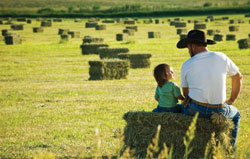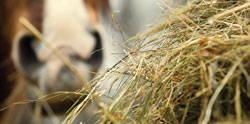 |
| Photo courtesy Istockphoto/magbug |
Top Five Key Points for Evaluating Hay
Forage (hay and pasture) is the main feed for horses. Good hay, fed properly, provides at least 90 per cent of the nutritional needs of most horses. This article will describe how to evaluate hay for horses and how to get the most out of the hay you have.
1.?Feeding Needs of Horses are Different from Cattle
First of all, horses have a very different digestive system from cattle. Horses have a stomach like a human along with a highly developed hindgut. In the hindgut vast populations of healthy microorganisms ferment fibre and release the nutrients to the horse. Cattle have a special foregut (rumen) designed to extract nutrients from fibrous feeds. In general, horses utilize good hay more efficiently than cattle, however cattle utilize lower quality hay better than horses.
Secondly, horses are raised to be athletes. As such, health, soundness, athletic performance and longevity are higher in priority than cost efficiency and convenience.
2.?Evaluating Hay for Horses
Check for Mold (zero tolerance)
Mold in hay is the most common cause of permanent respiratory problems in horses (e.g. heaves). Mold spores are able to enter the lungs where they cause permanent damage. Damaged lungs cannot effectively transfer oxygen into blood vessels and lungs lose their ability to contract. Because the risk of damage is high, the tolerance for mold in hay for horses is zero.
Two types of mold occur; the first is crusty mold caused by moisture, usually rain, getting into hay after it is baled. This mold is easily spotted and may not affect all bales. The more serious type of mold comes from hay that is baled too damp (above 18 per cent moisture). Generally, the hay looks good right after it is baled, then 4–8 weeks later it heats and produces a fine mold. This mold is more difficult to see and causes more damage. Fine, smoke-like spores are often observed when a flake is opened or dropped.
With freshly baled hay, one can check mold potential by feeling moisture and?/or heat when sliding a hand into a few bales. As well, the hay bales may be heavier than expected. Soaking moldy hay in water or feeding on the ground are not suitable options. However, moldy hay can be fed to cattle without the same risks. Dust should not be confused with mold. Ordinary dust is common in hay and is generally not a problem. These particles are large enough for the animal’s respiratory system to filter out.
Check Leaf-to-Stem Ratio
Leaves contain more nutrients than stems. Therefore, the higher proportion of leaves, the better the hay. Look for hay with 50 per cent or more leaves. Early plant growth is mostly leaves. As plants mature, stem increases and quality declines. Many hay growers take two crops of hay per year. They take an early cut just before flowering and a second cut in late summer or early fall. Quality of both cuts may be good. Hay that is cut once, late in the season, is often high in stems and lower in quality.
Check Texture of Stems
Fine stems have more nutrients than coarse stems. Stems should be soft and pliable, not stick-like. As plants mature, stems become coarser.
Check for Weeds, Colour
Weeds are wasteful as horses will not eat them. Very new or old hay fields may have excess weed material. Discoloured hay needs a close look. It may have been rained on. However, colour is not an issue if no mold is present and leaf-to-stem ratio is good.
3.?Know How Much to Feed
For most horses, the goal is to feed the amount of hay needed to meet the horse’s energy needs. If the horse is mature and in the proper body condition, one feeds enough hay to maintain a constant weight.
For example, an 1,100 lb mature horse at light work needs about 18 lbs of average quality hay to keep from gaining or losing weight (energy balance). A major issue is that, depending on the activity of the horse or the quality of the hay, horses can either eat a lot more or a lot less than they need. If the horse needs more energy than it can get from hay, either because the quality of hay is low or the activity is high, energy balance needs to be maintained by feeding grain — generally oats. If the horse can eat more hay than it needs, hay needs to be restricted.
The horse’s capacity to consume hay is controlled by the quality of the hay. The higher the quality hay is the more that a horse is able to eat and digest. Hay consumption varies with quality because good hay is fermented faster than poor hay. The rate at which hay is fermented is directly related to how much a horse can consume each day. If hay is good quality, horses can eat more than they need and become overweight. With good hay, intake may need to be restricted. With poor hay, grain may need to be fed to maintain weight.
Maximum Hay Intake Per Day
Hay Quality |
Hay Quantity per
|
|
Mature Horses Poor hay |
1.0–1.5 lbs (supplement with grain) |
|
Working Horses All hay types |
1.0–1.5 lbs |
|
Foals Good hay |
1.5 lbs |
Example Diets for Maintaining Weight of 1,100 lb Horse
Poor Haylbs/day |
Average Haylbs/day |
Excellent Haylbs/day |
|
|
Hay |
15 3 |
18 0 |
16 0 |
4.?Types of Hay
Hay contains either grasses, legumes or a mixture of grasses and legumes. Some common grasses in hay are brome, crested wheat grass and timothy. These are all good grasses and the difference in quality depends more on stage of cutting, age of stand and weather conditions than on the type of grass. The main legume in hay is alfalfa. Alfalfa is higher in quality than grasses. The best hay for horses is generally a second-cut, grass/alfalfa mixture. Clover is also a legume; however, some kinds of clover can be harmful to horses. In particular, Alsike Clover and Sweet Clover can be poisonous to horses and should not be fed.
 |
| Photo courtesy Istockphoto/seanfboggs |
5.?Avoid Wastage
Hay wastage is common throughout the horse industry. The majority of nutrients in hay are contained in the leaves. If hay is fed on the ground, at least 20 per cent is wasted and most of the losses are leaves. It is not uncommon to see horses that need 16 lbs of good hay being feed 25 or more pounds daily. Proper feeders for horses avoid wastage. A horse feeder should have a solid bottom, be at least 4 feet by 4 feet in size and 2 feet high. Because of competition within groups of horses, at least one feeder is required for every 2 or 3 horses.
Caution should be used when feeding large round bales. First of all, it is more difficult to evaluate mold in round bales. The outside may look good, however, the inside hay may have mold. Secondly, round bales are generally fed free choice. If the hay is good quality, horses eat more than they need. The final issue is wastage. Even with rings, a high proportion of leaf material is lost. If hay from round bales is hand fed, the issues regarding mold, wastage and hay restriction can be managed.
